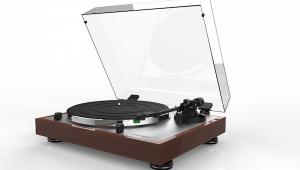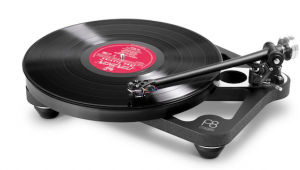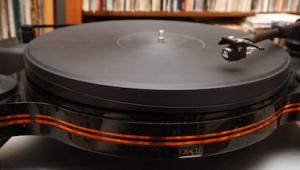Based on your review, it sounds to me like this table should have been packaged with the 2M Bronze. I realize MH is trying to hit a price point, but I think it would be a better table at $1695 with the Bronze. I personally was never impressed with the 2M Blue.
Music Hall Introduces its "Stealth" Direct Drive Turntable

Music Hall’s Roy Hall is kind of like that. He figured out a way to be in the turntable business for decades without having to invest in a turntable factory.
Today there are many players in the turntable business who don’t own their own factory, but Roy was a pioneer. He’s also owned more than few turntables and as a longtime friend of Linn’s founder and fellow Scotsman Ivor Tiefenbrun, no doubt the two indulged in many soused turntable design discussions, though probably little of it was retained by either one.
Being a personable and forward looking fellow, Roy forged an early relationship with Heinz Lichtenegger, another forward looker and modern era turntable pioneer who did own a turntable factory and thus in 1998 was born the MMF line of Music Hall turntables manufactured at the Pro-Ject factory to Mr. Hall’s specifications.
Hall’s Pro-Ject build ‘tables utilize some familiar-looking components including carbon fiber arms but also incorporate Hall’s own unique thinking about damping and isolation, which led to the company’s distinctive top of the line “layer cake” plinth look.
While in the early days Pro-Ject probably needed the OEM business to keep the factory running full throttle, that’s no longer the case, yet Mr. Lichtenegger clearly is not abandoning his old friend, though he probably no longer needs the outside business—not that I know any of this for certain: it’s just surmisal, though I do know for certain that the Pro-Ject factory is “booked” for production months into the future.
The Music Hall Stealth Turntable
Reaching “down market” in the face of low priced competition has been a difficult challenge for most manufacturers and even for those who design and market turntables without having invested in kitchens.
Music Hall has hit those lower prices points—as low as $299 including built in phono preamp— by contracting with a Taiwanese manufacturer that supplies “built to order” turntables to many well-known brands. It doesn’t take a particularly sharp eye to notice.
However, with the Stealth, the brand’s first direct drive turntable (and so new it’s not yet on the company’s website), Mr. Hall is trying something else: using that same manufacturer to produce a somewhat more costly, feature packed direct drive turntable that includes a pre-installed $239 Ortofon 2M Blue priced at $1495.
The new Stealth features include push button 33 1/3, 45 and 78rpm electronic speed control, auto shut off at end of play, an electricity saving “auto standby” mode and a set of RCA/RCA phono cables. It also incorporates a VTA/SRA “on the fly” feature I’ve not previously seen on that very familiar tone arm. Perhaps others have used it, but I’ve not seen it.

The arm is a 9” (230mm) effective length “S” shaped static balance design with a 22 degree offset angle and a standard detachable head shell, which of course is particularly useful if you plan on playing 78s or mono LPs.
More importantly, Mr. Hall has contracted for an unusually heavy, multi-layer and well-damped chassis as well as large, viscous-elastomer damped height-adjustable feet and a 4 pound, elastomer-damped die-cast aluminum platter (that’s what the instructions say it is, but it appears to me to be machined aluminum) that’s more massive and certainly far better damped than what’s typically found on turntables at this price point. The entire assemblage weights 24 pounds.
Another oddity in the manual is that it lists “audio specifications” that appear to have been “cut and pasted” from a model that includes a built-in phono preamp, which this turntable does not. Why else would it include channel separation and S/N ratio?
The direct drive motor is a brushless, low torque design that appears “familiar looking” (based upon what’s visible) on previous direct drive models I’ve reviewed manufactured for other companies by this Taiwanese company.
The bottom line is, Mr. Hall has spec’d from a high quality supplier a smartly conceived, feature-filled attractive design and priced it competitively. It’s not “cheap” but it’s also not expensive and if it performs well, it offers a great deal for the money. Oh, Hall saved money by offering a velvety soft dust cover instead of the usual hinged clear, rigid plastic one. I’ve not had a turntable with a dust cover for decades, so I think it’s a smart way to save money to keep the price down.
Measured Performance
A high resolution strobe disc made by Clearaudio demonstrated that the platter ran on speed at 33 1/3 and 45 and just slightly slow at 78, which is no big deal especially since 78s were often if not always “off” by a small amount.
Looking at the Platterspeed app graph and numbers also show that the platter spun at or very close speed (too small a deviation to matter) and deviations were more than reasonable given the turntable’s price point. That green line can look very flat if you’re willing to spend a great deal more money.
The Shaknspin measurements were equally good and basically confirmed the above:

Please keep in mind that these measurement devices produce results that are useful in relative terms but hardly dispositive of turntable performance. While they are less than perfect measurement devices (and that’s true of every test record!), over time I’ve seen that the better turntables consistently produce better measured and visual results.
“Tap tests” on both the stand upon which the turntable sat and on the plinth itself demonstrated that the Stealth is in that regard extremely “stealthy” and performed better than some turntables costing 3X more. There are a few companies that try everything to achieve this performance level but never manage and always produce “lively” plinths and far less effective isolation.
Sonic Performance
Unlike some other moderately priced ‘tables that both transmit outside vibrations and resonate internally (the “tap test” isn’t 100% foolproof but it provides a pretty good idea), the Stealth’s low resonance performance and excellent rejection of external vibrational energy correctly predicted that its sound would be neutral rather than “warm” and that bass performance would be clean and “fast” and not soft and “full” sounding.
The Stealth was lean and clean in the best senses of those words. If you want warmth get it from the transducer. The Ortofon 2M Blue does not have a “rich, warm” sound and the Stealth did not add it. It does, however, have a pleasingly concise, focused sound and the Stealth delivered it.
Just delivered by mail were two offerings from The Tipitina Record Club. I couldn’t resist playing Professor Longhair Fess at Home (TRC-0101), a 1973 recording produced at his home by Quint Davis, now producer of the New Orleans Jazz & Heritage Festival founded by George Wein. Glad I did!
Despite having no reference point since I’ve not before heard the record, I can confidently write that the Stealth does the “rhythm’n’pacing” thing very well. Its presentation of Professor Longhair (a/k/a Henry Roeland Byrd)’s piano was coherent, especially on the bottom octaves where the ‘table didn’t soften or add warmth. Percussionist Alfred “Uganda” Roberts’ percussion, working in lockstep with Byrd, popped nicely behind and the living room ambience floated nicely in the background. Byrd’s vocalizing (couldn’t really call it singing) sat nicely and three dimensionally in the foreground. When I played it again on the reference rig while everything popped up a few major notches in terms of harmonic structure, three dimensionality, transparency and stage depth, the overall picture was pleasingly recognizable, especially rhythmically and timbrally.
The second record from the Tipitina’s Record Clug sent my way is James Booker’s True-Live at Tipitina’s (TRC-0104). If Booker’s dazzling solo take on “Malaguena” doesn’t get your heart racing, it’s either because the dancing keys have already stopped it or your turntable can’t keep up with the action. Again the $1500 ‘table did a great job communicating the rhythmic message but fell short on the harmonic and dynamic structure compared to a rig costing well over 100X as much. But without comparison the Stealth driving the QHW “The Vinyl” phono preamp kept me involved and kind of overwhelmed by Booker’s magical fingers. Neither of these records are of “audiophile” quality but they are direct, exciting and immediate musical documents.
The first drum “pop” on Lee Morgan’s “The Sidewinder” from the now sold out 12 LP set The Complete Live at the Lighthouse (Blue Note B0031954-01) sealed the deal for me.The biggest limitation here is the pretty good Ortofon Blue but no doubt this arm can handle a far more costly and sophisticated cartridge and with extra head shells available for $35.
I happened to have “lying around” an Adcom Crosscoil low output moving coil cartridge mounted on a compatible head shell. This cartridge had been rebuilt by The Garrott Brothers (the real guys—not long before they committed suicide along with their wives). That produced an enormous sonic change, not surprisingly, adding layers of harmonic integrity, richness, warmth and detail resolution, proving my point (at least to me) that this Stealth turntable is a remarkably neutral carrier that more expresses the cartridge being used with it than the record spinner itself.
Conclusion
Music Hall waited more than 20 years before launching a direct drive turntable. It was worth the wait if you are into direct drive. Not everyone is. The belt die-hards probably will not be interested but those of you who might be interested in a moderately priced, low torque direct drive spin that’s intended to compete with the “T” brand, ought to consider the Stealth before making your purchase. I wish I had a comparably priced “T” brand model here to do a direct comparison, but I do not.
Therefore, I’ll conclude by saying the Stealth is a stylish, well-performing and fine sounding, moderately priced, well-damped and isolated direct drive turntable, the sound of which is limited mainly by your choice of cartridge. It sounds timbrally well-balanced but somewhat harmonically astringent with the supplied $230 Ortofon 2M Blue but consider that observation was made using a system costing more than the average American home. Fitted with a better cartridge, the Stealth might have fooled some listeners for at least a short time into thinking the ‘table was commensurately priced with the rest of kthe system. According to Mr. Hall, expect the Stealth to be widely available in October of 2021.
- Log in or register to post comments

...why companies include a cartridge on the lower priced/lower end tables. IMHO, once you get to the $1000+ price range it should be an "option". You should be able to buy the table/arm by itself.
Seems to me, this table deserves a much nicer cart, (the Blue is fine, but not in the same league as the table/arm).

In the $1000+, I don't think any cartridge should be included. I don't mind Rega offering packages that include them, but, I think it's also great that you don't have to spend $200 toward a cartridge you won't use. They offer a nice discount if you add their cartridge, but you aren't obligatorily stuck with it.

I've been looking to upgrade from my Music Hall mmf-2.3 and haven't been happy with anything they've put out lately. I'll have to see more photos of this table to get a better aesthetic idea whether or not I like it. It's at the top of my price range for an upgrade and I've been hoping to stay with the brand, although to be honest, I have been looking at the X1 and X2 tables by Pro-Ject lately. I'll keep my fingers crossed and hope this one is a contender.

You are seeing more companies slowly embracing DD as a power option and that's a good thing. I would look at this if I were in the market but honestly, its two biggest competitors the Technics 1500C and Technics 1200GR are formidable foes.

... an Ortofon 2M Blue stylus (or an Audio-Technica AT-VM95SH cartridge) and a KAB TD-1000 fluid damper.
https://www.lowbeats.de/ortofon-2m-blue-mm-system-zum-toppreis/
https://www.lowbeats.de/test-audio-technica-vm95-6-mm-abtaster-bis-200-e...

... accessories to get - not an order.
Besides, one definition of "get" is to "seek out".
(It's remarkable that you have the time to be concerned with semantics when your website has published a review of, and thus promoted, a phono preamp whose design was plagiarized.)

Ortofan, pretty much all you ever post is links to other products at the end of a review without ever adding anything of substance that you've written yourself. I don't think you've ever added anything worthwhile that you have actual experience of. It's really tiring and often equates to nothing more than spamming.

...any proof that the York preamp was "plagiarized"?
I read that discussion and saw the complaint by another designer, but no proof.

really interesting. I wonder how the tonearms would compare? I would think the "T" motors are better, but who knows.
I kinda think I might like a Sumiko Moonstone kind of sound as Michael describes this table's apparent signature.

your sole intent appears to be to contradict, irritate and insult. You add nothing to the conversation. Take a hint and get lost.

I could see Pro-Ject or E.A.T. producing some DD tables since they have the capability at their factory.

...that Pro-Ject didn't have a DD table first, since they make the tables for Music Hall. I bet one is just around the corner...

Pro-Ject does not make this turntable for Music Hall. It's built in Taiwan. Pro-Ject does not have DD technology. They have to source it from Taiwan, China or a high-end unit from Alfred Langer in Germany who has designed his own that he sells to others.

The Music Hall is similarly priced to the Cambridge Alva, which received a very positive review here if I recall correctly. Your thoughts?

Agreed that a channel separation spec. is meaningless to be applied to only a TT, but back in the 70s, I recall some manufacturers would call rumble the S/N ratio. So why don't you measure rumble?

Call it $1500 for a DD TT - by today's standards that is a good value. Similar DD tables usually start around $2400 and higher end ones are the price of a luxury car or a down payment for one.
I wouldn't worry about the Ortfon 2M Blue much, it is an excellent starter cart and not a bad cart overall. Cart sounds also depend on tonearm pairing. For example, a 2M Blue can sound a bit rough or unpleasant on one tonearm and table and very pleasant or near perfect match on another. I have a stock Denon DP47-f table with a 2M Bronze. It sounds fine, but the Bronze is really pushing the envelope for the arm. I have read several times that the 2M Blue is a better match for that arm and table. I bought it NOS and it had a Sumiko Blue #2 on it and sounded like a backwoods dull saw (and that was running through a high-end AVR with phono stage and tried again with a Musical Surroundings Phonomena 2. The Bronze was a huge improvement. I now run separates with a Parasound JC3 Jr and that upped the game. I have a NOS Denon DL110 waiting in the wings. I know a MC will sound different from an MM. Better? Not likely, but different.
My Denon is DD as is my old Pioneer PL-510, both run at deadly accurate speed with no noticeable deviation to the ear and hardly a blip on measurement. With the exception of the old Technics 1200s, DD tables from back in the founding days of HiFi were built like brick chicken houses and very accurate. I have that Pioneer that can prove that point. (Shocking to me as well for a lucky swap meet find years ago).
I also am very curious to see if industry rock star Heinz comes off with a DD table (or knowing him, two or three variations as well for all concerned at price points for every budget). His wife will follow with a higher-priced DD table, while many including yours truly would not be able to afford it, but it will be a work of art for the cost as well. (Love the EAT stuff even if I cant afford it, it is enjoyable enough just to look at).

Interesting turntable and nice review. It did spike my interest in how are you still able to use the Platterspeed App? I really miss using this app to calibrate my Garrard 401 since the developers stopped supporting it and it’s no longer available on the App Store. I’d love to know how to install it on an old phone that I’m happy to use as a dedicated device for this purpose.

What did you do with yours?

It works very well in some programs if we get the essence uno online of the product paharm.

Sprunki Pyraminx 7 Slots is a game that brilliantly merges puzzle-solving with rhythm-based gameplay, offering a unique and engaging experience. 7slotsplay can be enjoyed online for free.



























































